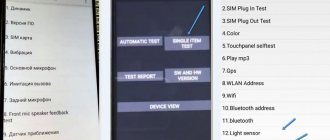There was a time when wired Internet speed was measured in kilobauds (kilobits per second), and 14,400 baud was considered a good value. Today, wired access operates in hundreds of megabits/second, and this no longer surprises anyone. But the speed of wireless communication is noticeably lagging behind, and the efforts of developers are focused on promoting new high-speed communication standards.
The transition from 2G to 3G could not be called revolutionary, but the progress was obvious. Fourth generation networks have made it possible to bring the standards of mobile Internet access closer to wired technologies. But - with some restrictions. Today we will tell you about them, as well as about ways to connect Android smartphones to the 4G (LTE) standard.
What is an LTE network on an Android phone?
Although the concepts of LTE and 4G are not equivalent in the technical literature, both terms are actively used to refer to fourth generation networks.
In fact, the 4G LTE standard can be considered as an intermediate stage in the evolution from 3G to networks starting with four (full 4G, its extension 4G+ and a half-frequent 4.5G solution, something in between 4/5G). Considering how much data flows circulating over mobile networks have increased, it can be argued that the transition to high-speed networks is overdue and is an urgent need. However, LTE technology is already preparing an even more impressive replacement - 5G networks, the development of which is already at the experimental launch stage.
If we talk about technology in relation to smartphones, then you need to know the following: this is a radio module included in the phone, capable of operating in an extended frequency range (from 1.4 to 20 MHz) with the implementation of the channel differentiation function. In simple terms, 4G LTE provides much more radio bandwidth than 3G. As a result, it became possible to provide higher data transfer rates while improving the quality of cellular communications. Streaming video, IP telephony, video calls - all these things are impossible with mass use in 3G networks, but now they are actively used by both the business sector and ordinary people.
Thus, those 3 MB/sec, which satisfied users for a long time within 3G, have today been replaced by speeds of about 21-75 MB/sec. The difference is obvious. But you need to understand that increased data transfer speed is not the only trump card of 4G LTE. Other advantages of the standard include the following:
- ensuring communication stability - it will remain stable in the zone of reliable reception, even if you move at speeds of about 300 km/h;
- the frequency range of the standard has been significantly expanded;
- transmission of packet data sets is carried out using radio switching.
It cannot be said that networks today cover the entire planet - even in South Korea, where this figure is the highest, the coverage level is 96%. In Russia, 50% of the territory is covered by fourth generation networks provided by the so-called “Big Four” domestic mobile operators (MTS, Beeline, MegaFon plus the growing Tele2).
Setting up 4G on Android
Connecting and setting up 3G Internet on Android
A tablet or smartphone usually independently installs all the settings it needs. But if they are lost or for some reason not installed, you should restore them manually.
How to set the 4G setting on Android? To do this you need:
- Go to the SIM card settings menu and select “Network settings” or “Access point”. In different phone firmwares they have different versions in the name.
- Fill in the fields for password, login, Network name and access point. These are the main parameters. Do not fill in all the others; they are restored automatically when connected.
To write the required information, you need to know:
- Network name: Beeline, MTS, Megafon or other operator.
- Access point addresses: for MTS - internet.mts.ru, for Megafon - internet.
- The password for Megafon is gdata, for Beeline - beeline, MTS - mts.
How to disable 4G on Android? To do this, you need to perform all the same steps as for connecting:
- In the “Settings” section of your phone, select the “Wireless networks”, “Wi-Fi networks” or “More” option.
- Select "Mobile networks".
- Choose a different connection type or remove it altogether. To do this, move the cursor to the “Disable” button.
Additional Information . If you need to completely interrupt the connection to the Internet, in the “Mobile networks” column, click “Disconnect”.
Switch from 3G to 4G
Are the Internet settings on a 4G phone different from those on a 3G phone? Of course not. In order to change the speed from 3G to 4G, you need to carry out all the same steps as for regular Internet settings.
If you are interested in how to switch 3G to 4G, first you need to make sure that your phone supports modern technologies. The smartphone is covered by the operator's 4G coverage. If the gadget does not automatically change the settings, check whether the SIM card supports such a service. When all the points are completed, but there is no Internet, we set it up manually. How to turn 3G into 4G on Android? For this:
- In the gadget menu, select the “Settings” icon.
- Select the “Mobile networks”, “More” or “Other networks” section. Each smartphone is called differently.
- Select “Network Mode” or “Network Type”. In this way we switch between connections. WCDMA is suitable for connecting to 3G, LTE for 4G.
Important! If one of the connections is missing, the gadget does not support it and you cannot add a mode.
Checking smartphone compatibility with 4G
Your mobile device may be capable of high speeds. How do you know if you can enjoy the opportunity to work on 4th generation networks? There are several ways to perform this check.
Checking your smartphone's SIM card
The first limitation to overcome concerns the SIM card itself. If it doesn't support 4G LTE, you'll have to replace it. The method is simple. Just enter a special code and press the call button. The problem is that this code is different for mobile operators. You can find out the appropriate USSD code combination on the official website of the service provider.
So, for Tele2 this combination looks like *156#, for Beeline - *110*181#, for Megafon - *507#. Finally, for MTS it is *156#.
After dialing the code and pressing the call button, you should receive an SMS message informing you whether you can use high-speed access or whether you will have to change your SIM card. Note that LTE networks began to be implemented in Russia in 2012, so if the SIM card was released later, most likely it is in the USIM format, which means you will not be left without 4G.
Possible problems
If the phone does not work on the 4G network, then the reasons for the problem may be different:
- The mobile device does not support the 4G-LTE standard.
- The operator does not provide 4G network access services.
- The phone is out of coverage area.
- Mobile Internet is not configured.
If the first three reasons are difficult to deal with, then every user can check the status of the mobile Internet and, if necessary, configure it. The first thing you need to do is make sure that mobile data is turned on.
If the transfer is enabled, but an error appears when starting the browser, check the access point settings. They are usually installed automatically when you insert a SIM card into your phone. But, for example, after a firmware update, the APN points may be reset. There are two ways to restore them.
- Receive automatically by ordering an SMS with the configuration from your operator.
- Register manually by looking at the setup data on the operator’s website.
If you encounter any difficulties, you can contact technical support. They will accept the request and send a configuration message, after saving which the APN point will work again, just like the mobile Internet.
Verification via phone
The second limitation is related to the phone itself. Old push-button phones obviously lack the ability to receive data at high speeds. But modern smartphones are different. Frankly budget Chinese models may also not support the LTE standard, so this fact must be taken into account when testing the phone. And you can do this in different ways:
- using the same USSD codes as for identifying a SIM card. The possible answer is that the SIM card supports 4G, but the phone does not;
- When purchasing a new smartphone, carefully read the instructions, where all supported networks will be listed in the phone's specifications. If among them there are the designations 4G/LTE/WiMAX, this means that the device supports operation in fourth generation networks. The same data is usually given on the box (packaging);
- If you are one of those users who are not used to cluttering your desktop drawers with phone boxes along with instructions, you will have to use a different method. Go to the “Settings” item of your smartphone, select the “About phone” sub-item and the section describing the status of installed SIM cards, where, among other characteristics, the connection type is indicated. Depending on the Android version and device model, the access path and menu item names may differ, but in principle you understand where to look;
- in extreme cases, no one bothers you to find the necessary information on the Internet - any website that sells smartphones indicates the full technical specifications of each model. Another thing is that you shouldn’t trust such data 100%, so use several sources of information.
Checking operator coverage
Finally, the third limitation concerns coverage in a given area. Even if you have the latest smartphone and choose an expensive plan, you won't be able to take advantage of all the benefits of high-speed communication if your locality is not covered by a 4G LTE network.
We have already noted that approximately half of the territory of our country is not covered by this standard. To find out if you are one of those unlucky with 4G, go to the official website of your mobile operator and select the section called “Coverage Map”. Use the zoom buttons to quickly find your locality and see if the fourth generation communication standard works here.
Installing 4G and LTE on Android
Regardless of the operator or manufacturer of your gadget, the Android system always looks almost the same. Therefore, to connect to high-speed Internet you need to do the following:
- Open the main menu and select settings.
- Click on "More" or "Other networks".
- Select Mobile Networks.
- In the window that appears, check the “Mobile data” line, then select “Access points”.
- Select the pop-up (context) menu and click New Access Point.
How to set up 4G Internet? You will need to fill out a profile to connect to the Internet. What matters here is what operator you have, so select the necessary information from the data below.
You need to enter the following values:
- Setting up and enabling LTE on iPhone 5S and iPhone 6S
- Name: Beeline, MTS, Megafon or Tele2 Internet, depending on which operator you use.
- Access Point (APN):
- MTS - internet.mts.ru.
- Beeline - internet.beeline.ru.
- Megafon - internet
- Tele2 - m.teleru
- Username:
- MTS - mts
- Beeline - beeline
- Megafon – gdata
- Tele2 - leave field blank
- Password:
- MTS - mts
- Beeline - beeline
- Megafon – gdata
- Tele2 - leave the field blank
- Authentication type: PAP for all operators.
- Access point type: default for all operators.
Additionally, for Tele2 the proxy server should be left disabled.
Once completed, save the profile and make sure it is selected and activated. It may be worth rebooting your device for the system changes to take effect. After this, you should have 4G LTE Internet.
How to set up LTE on Android
If all of the above checks turned out to be positive, it’s too early to rejoice. You also need to enable LTE mode on your phone. There are two ways to do this. Automatic setup is simple, and the smartphone itself determines that it is within the coverage area of the 4G network and activates the appropriate communication mode. Manual setup is much more complicated and is used if for some reason automatic setup is not available.
Let's consider both methods.
Manual setting
Let's look at how to enable 4G mode on smartphones running Android OS manually. To do this, go to “Settings”, where we are interested in the “Mobile networks” tab. Select the “Advanced” option (or “Other networks”, depending on the implementation of the function), where we need to click on the item called “Access Point”.
Click on the “+” icon to create a new point and indicate all the necessary information, from the name to the types of protocols used. All this data can be obtained on the official website of the mobile operator. Usually the “authentication type” is specified as PAP, the APN type is default. When all fields are filled out without errors, you can exit the settings and use high-speed Internet.
Automatic setup
The automatic method of adjusting Internet speed for 4G assumes that the switch will occur without your participation, depending on the type of coverage in a particular area.
Let's say, if you live in a locality where only 3G networks are available, when you move to an area where there is high-speed 4G Internet, the mode switch should happen automatically, without your participation. But it is always possible to force 4G to be installed on an Android device - to do this, go to “Mobile networks” again, and in the “network type” subsection indicate “4G”, it is usually marked as a recommended parameter.
As you can see, if a smartphone supports fourth generation networks, you do not need to use additional tools or have root rights to enable and configure them.
How to force 4G mode so that your phone or modem can only receive in this mode
In order for a smartphone to make a forced connection to the fourth generation network, you must set the appropriate parameters for the connection:
- Open system “Settings” or “Options”.
- Go to “Wireless networks” or “Manage mobile networks”.
- Select the “Mobile Network” tab.
- Find the “Network Type” item in the list.
- In the dialog box about.
Important! This method will only work if there is stable 4G or LTE coverage in the area.
On Sony Xperia
Go to Settings - More.
Choose a mobile network.
Then "Preferred network type".
Click "LTE (Preferred)".
Meizu m5
The connection to Meiza M5 is also very similar. To select the network type, go to settings. In the “Operator Selection” tab, click on the current operator. Go to the “Network Mode” tab and select “4G Priority”. To finish, click the Back button.
Let's consider the connection on Meizu U10. Call the main menu and select settings.
Next, go to the “Sim cards and networks” section.
Click Network Mode.
And select the desired option.
How to connect 4G to Lenovo
Let's try to connect 4G Internet on the Lenovo YOGA Tablet -2.
Go to settings.
Click "More".
Move to mobile networks.
Click "Network Type".
Select "4G (recommended)".
How to enable 4G on Xiaomi
The MIUI operating system is installed here. But in terms of settings, it resembles Android. Let's look at the MI5 phone as an example.
Open Settings – Mobile network. The required section may be called “SIM cards and mobile networks”, “Data transfer”.
Open the “Mobile network” section and click on the current SIM card (in this case, Beeline).
Select "Network Type".
Click "Prefer 4G".
Similarly, 4G can be connected in MI4 and Redmi 3s models - the names of menu items depend not on the phone model, but on the firmware. For example, on a Tele2 phone (Redmi Note 4x model) the sequence will be as follows:
Open the menu at the top and select settings.
Next, select “Sim cards and mobile networks”.
Click on the designation of the TELE2 SIM card.
Select the network type.
And we connect LTE.
How to make 4G on Windows Background
The phone from Microsoft runs on Windows OS. So for PC users everything here will be familiar. Let's look at how to connect using Nokia Lumia as an example. It is worth noting that even with the Windows 10 operating system, not all phones have the ability to work in 4G.
Go to the menu and find the “Options” item. Click on it.
Next, select “Network and wireless devices.”
Go to “Data transfer and SIM”.
Click the "Sim Card 1 Settings" link. Please note that it looks like a simple signature, but at the same time it contains the item we need.
In the “Highest connection speed” drop-down list, select the desired option.
In other OS versions, the required item may be in the “Cellular + SIM” menu.
Go to the SIM card settings.
Click under "Fastest connection" and select 4G.
At this point, the phone settings are completed, LTE was connected.
We did not tell you how to enable 4G on LG g3 (as well as k10, k8, g2) and on many other models and brands of phones. But in conclusion, I would like to draw your attention to the fact that the principle of connecting to 4G on all smartphones is the same and it depends on the operating system. Modern mobile devices can be divided into four classes: Android, IOS, MIUI and Windows. Therefore, if you did not find in our review how to connect your particular model, just find out its OS and proceed by analogy.
How to enable 4G on a Samsung Android device
The fourth generation Internet on Samsung phones is activated a little differently. The features of the models from this manufacturer have slightly modified the Android system familiar to users. To install 4G, you will need to open the menu and select the “Settings” icon. Inside, find the “Other networks” item. We need a subsection “Mobile networks”.
A list of options will appear on the screen, the activation and deactivation of which can be controlled. For the phone to perform mobile data transfer, there must be a check mark next to the “Mobile data” item. Below is the inscription “Network modes”. Here the position “Lte” is set, which is identical to 4G.
After completing simple setup steps, you can try using the Internet on your Samsung phone. If the data transfer speed does not improve, the problem may not be with the settings. Some devices do not support 4G (this aspect is specified in the instructions for the phone).
Another reason for low Internet speed is the choice of mobile operator. If Tele2 settings are installed on Android and sites load slowly, it means that this communication provider does not support 4G in a particular region.
Using high-speed Internet justifies the time and money spent on setup. It’s not difficult to figure out how to connect 4G to a tablet or phone. Anyone can do it by spending a few minutes studying the instructions.
How to check the functionality of LTE mode
If you are unable to feel how much faster the data transfer speed has become, you should use a special application to measure this parameter. And some programs can determine why the network is slow, diagnosing the reasons for the slowdown (poor coverage, weak radio module power, etc.).
A good application for Android is the nPerf utility, which uses a unique proprietary algorithm for measuring Internet speed with very high accuracy.
If testing is unsuccessful, it means that you made a mistake at the stage of setting up high-speed Internet. Let's look at the most common of them along with ways to eliminate them:
- The “Mobile data” menu item is not activated. The solution is obvious: move the switch slider to the “On” position. ("On");
- The access point for your operator is missing (for example, it was deleted due to negligence). Your actions are to add it in accordance with the algorithm described above;
- the test failed due to the lack of mobile traffic in your tariff, or if it is exhausted. And here the problem can be solved quite simply by replenishing your account or changing the tariff. All these actions can be performed in your personal account on the operator’s website.
Known problems (errors) and their solutions
The most common problem that occurs mainly among inexperienced users is the lack of a mobile Internet signal.
The tariff is chosen correctly, paid on time, and there is coverage, but 4G still does not work. What is the reason?
- And the reason is the most banal: the “Mobile data” . You just need to move the slider to “On” , and then the Internet will be instantly activated.
- Next problem: lack of access point. It happens that there is no access to a certain operator. In this case, you need to manually add this point, as we wrote above.
- And finally, let’s leave the most banal, but important factors: you simply forgot to pay the tariff or the SIM card has expired. To avoid these minor troubles, do not throw away your tariff package and do not forget to look into your personal account provided by the operator.
How to disable 4G network
There is a category of users who use the Internet exclusively at home or at work (in an educational institution). As a rule, in such places the Internet is distributed via Wi-Fi, that is, without the need to use mobile traffic. In addition, many smartphone owners use tariffs with a limited amount of traffic, which is not always enough within the chosen package. In such cases, there is a need to temporarily or permanently disable 4G, since in terms of megabit consumption this network is the most voracious.
This is done using an algorithm similar to enabling this function. But there are already so many versions of Android that it is not possible to list all the possible combinations of tab names, so you may have to dig into the phone’s settings to get to the necessary items. However, this work cannot be called useless: the better you know your smartphone, the more fully you will be able to use its capabilities.
So, we need to find the “Mobile networks” tab in “Settings” (perhaps it is located in the “Access networks and Internet” tab), where a list of communication standards available for this phone model will be displayed. All you have to do is make a choice not in favor of 4G LTE and confirm your choice. After this, the phone will only work at speeds corresponding to the selected standard.
We hope that the algorithms described above for checking, connecting and disconnecting the high-speed 4G standard will not raise any questions for you. If you encounter problems, describe them in the comments, not forgetting to indicate the phone model, Android version and mobile operator whose SIM card you use.
Enabling 4G on stock Android
To activate the service on your phone, you must fulfill a number of conditions:
- Have a SIM card that supports 4G. The card should say "4G LTE". If this mark is not present, you need to contact a mobile phone store and replace the Sim. The service is provided free of charge.
- Make sure that the phone is located in a region with 4G coverage. To verify this, you need to go to the operator’s website in the technical support section and find the required location on the coverage map.
- The smartphone must support modern technology. You need to check in the “Settings” section and find the corresponding item there. If it is not there, you should change the gadget.
The question arose, how to enable 4G on Android 6.0 - 7.0? To connect to the service on a device with a regular Android without additional shells (this includes brands Huawei, Sony Xperia, S-tell) you need:
- In the smartphone menu, select the “Settings” section and go to the “More” item.
- Select the “Mobile networks” section.
- Then select “Network type” and open its settings.
- In the window that opens, select the connection type “LTE (4G)” or “LTE recommended”. This is what you need to use high-speed Internet.
How to connect 4G on a Samsung phone
Samsung develops and produces phone models on the Android operating system, but using a personal interface. To enable 4G you need:
- In the “Settings” section, select “Other networks”.
- Select “Mobile networks” from the menu.
- After that - “Network mode”.
- In this section, select “LTE/WCDMA/GSM”, which is necessary for connecting to 4G.
- Connecting to the Internet occurs without rebooting the smartphone.
How to set up 4G on an LG phone
Smartphones use two methods to connect to the Internet. First:
- Enable data transfer in the gadget.
- Dial code *#*#4636#*#* in your phone. Go to the menu that opens and select the “Phone Information” section.
- At the bottom, select “Recommended network mode” and “LTE/WCDMA”.
- After exiting the menu, the “4G/LTE” icon will appear at the top of the phone.
Setting up the second 4G option:
If the first method did not work and you couldn’t get into the phone menu, you need to:
- Dial code “3845#*802#”.
- Go to the “LTE Only” menu, then – the “Network Mode” section, the preferred networks “GSM/WCDMA/LTE”.
How to install 4G on other phones
Xiaomi develops gadgets on Android, but with the MIUI shell. After such firmware, the interface changes greatly and begins to differ significantly from the standard version. Typically, smartphones of this brand are already configured by the manufacturer, but if something goes wrong, or there are no factory settings, this is done manually:
- LTE - what is it in a phone, how to use it
- Go to “Settings”. In different versions, the required section may be called “Mobile network”, “Data transfer” or “SIM cards and mobile networks”.
- Next, select the SIM card through which you want to connect to the Internet.
- Next in the section, select “Network Type”.
- And in the menu that opens, select LTE (4G).










